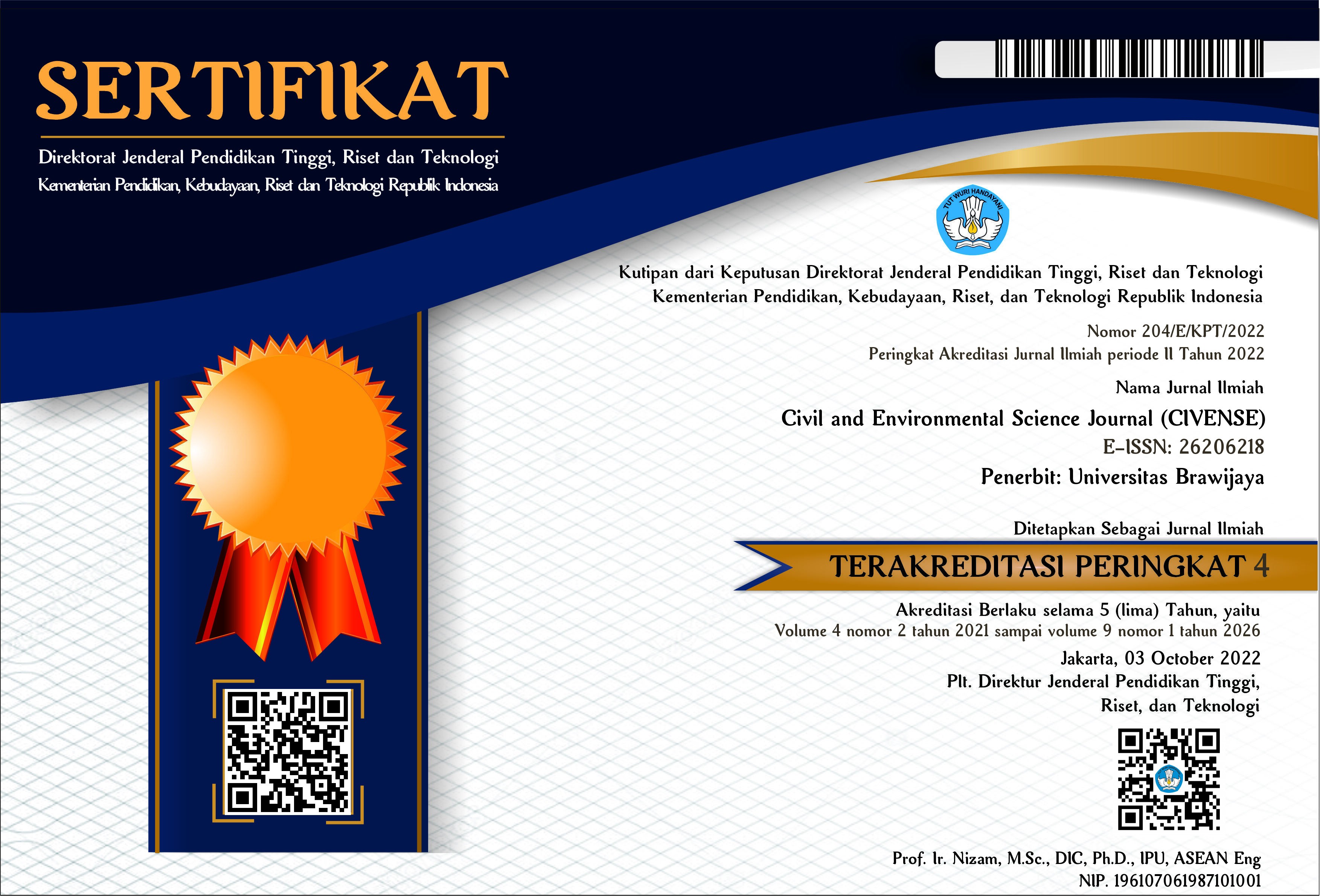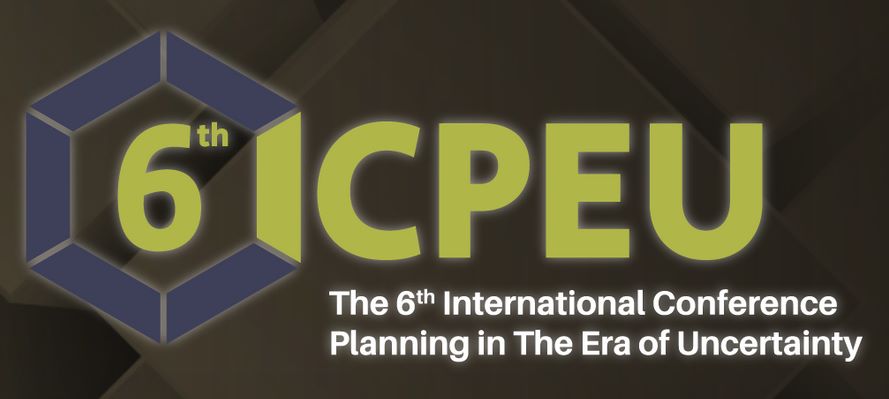Speed, Density, and Crash Relationship in Urban Arterial Roads
DOI:
https://doi.org/10.21776/civense.v6i2.401Keywords:
Accident, Speed, Traffic, Density, RelationshipAbstract
Vehicle speed has an essential role in the occurrence of traffic accidents. Increasing the number of vehicles operating on the road will further increase the risk of traffic accidents because it is not balanced with discipline in driving. This study's purpose is to analyze the relationship between speed and traffic accidents that occurred in Gadjah Mada and Hayam Wuruk Road, Jember, through several variations of calculations. The independent variables used are average speed and 85th percentile speed and density, while the dependent variable used is the accident rate. The analysis used is a correlation test that determines the level of closeness of the relationship between the two variables and a regression test that helps estimate the relationship between the two variables through a regression equation model that will be selected based on conditions in the field. The results of this study indicate that lower speed is associated with a lower accident rate. Meanwhile, lower vehicle density leads to an increase in the accident rate. Speed management to improve traffic safety in Indonesia is needed. Direction for future research is presented.
References
S. Sulistyono, R. N. Listyawati, N. N. Hayati, H. Wahono, B. Hendrawan, and E. H. Prayitno, “Evaluasi Implementasi Program Keselamatan Jalan ‘Ok Bos’ Di Jawa Timur Dalam Menurunkan Kejadian Kecelakaan Lalu Lintas,” Journal of Indonesia Road Safety, vol. 1, no. 3, pp. 117–127, 2018, doi: 10.19184/korlantas-jirs.v1i3.14776.
K. Goniewicz, M. Goniewicz, W. Pawłowski, and P. Fiedor, “Road accident rates: strategies and programmes for improving road traffic safety,” European journal of trauma and emergency surgery, vol. 42, pp. 433–438, 2016, doi: 10.1007/s00068-015-0544-6.
C. P. Raj, S. S. Datta, V. Jayanthi, Z. Singh, and V. Senthilvel, “Study of knowledge and behavioural patterns with regard to road safety among high school children in a rural community in Tamil Nadu, India,” Indian journal of medical specialities, vol. 2, no. 2, p. 110, 2011, doi: 10.7713/ijms.2011.0028.
S. M. Sabbour and J. M. Ibrahim, “Driving behaviour, driver style and road traffic accidents among young medical group,” Injury Prevention, vol. 16, no. Suppl 1, pp. A33–A33, 2010, doi: 10.1136/ip.2010.029215.120.
W. Kriswardhana et al., “Modeling the probability of speeding behaviour and accident involvement using binary logistic regression in East Java Province,” Journal of Indonesia road safety, vol. 2, no. 3, pp. 149–158, 2020, doi: 10.19184/korlantas-jirs.v2i3.15048.
N. L. W. R. Kurniati, I. Setiawan, and S. Sihombing, “Keselamatan Berlalu Lintas di Kota Bogor,” Jurnal Manajemen Transportasi & Logistik (JMTRANSLOG), vol. 4, no. 1, pp. 75–88, 2017, doi: 10.25292/j.mtl.v4i1.78.
H. Widyastuti, “Valuing motorcycle casualties in developing countries using willingness-to pay method: stated-preference discrete choice modelling approach.” Newcastle University, 2012.
N. N. Hayati, S. Sulistyono, and J. S. M. Wijaya, “Identifikasi Karakteristik Dan Lokasi Rawan Kecelakaan Lalu Lintas Pada Jalur Pantura Surabaya–Tuban,” Universitas Jember, 2012.
Y. Kitamura, M. Hayashi, and E. Yagi, “Traffic problems in Southeast Asia featuring the case of Cambodia’s traffic accidents involving motorcycles,” IATSS research, vol. 42, no. 4, pp. 163–170, 2018, doi: 10.1016/j.iatssr.2018.11.001.
F. Lai, O. Carsten, and F. Tate, “How much benefit does Intelligent Speed Adaptation deliver: An analysis of its potential contribution to safety and environment,” Accident Analysis & Prevention, vol. 48, pp. 63–72, 2012, doi: 10.1016/j.aap.2011.04.011.
H. Wells, “Risk and expertise in the speed limit enforcement debate: Challenges, adaptations and responses,” Criminology & Criminal Justice, vol. 11, no. 3, pp. 225–241, 2011, doi: 10.1177/1748895811401976.
D. D. Clarke, P. Ward, C. Bartle, and W. Truman, “Killer crashes: fatal road traffic accidents in the UK,” Accident Analysis & Prevention, vol. 42, no. 2, pp. 764–770, 2010, doi: 10.1016/j.aap.2009.11.008.
H. C. Joksch, “An empirical relation between fatal accident involvement per accident involvement and speed,” Accident Analysis & Prevention, vol. 7, no. 2, pp. 129–132, 1975, doi: 10.1016/0001-4575(75)90007-X.
X. Pei, S. C. Wong, and N.-N. Sze, “The roles of exposure and speed in road safety analysis,” Accident analysis & prevention, vol. 48, pp. 464–471, 2012, doi: 10.1016/j.aap.2012.03.005.
D. Solomon, “Crashes on main rural highways related to speed, driver and vehicle,” Bureau of Public Roads, 1964.
K. M. Kockelman and J. Ma, “Freeway speeds and speed variations preceding crashes, within and across lanes,” in Journal of the Transportation Research Forum, 2007, vol. 46, no. 1424-2016–117787, pp. 43–61, doi: 10.5399/osu/jtrf.46.1.976.
M. Quddus, “Exploring the relationship between average speed, speed variation, and accident rates using spatial statistical models and GIS,” Journal of Transportation Safety & Security, vol. 5, no. 1, pp. 27–45, 2013, doi: 10.1080/19439962.2012.705232.
D. Lord, A. Manar, and A. Vizioli, “Modeling crash-flow-density and crash-flow-V/C ratio relationships for rural and urban freeway segments,” Accident Analysis & Prevention, vol. 37, no. 1, pp. 185–199, 2005, doi: 10.1016/j.aap.2004.07.003.
L. Aarts and I. Van Schagen, “Driving speed and the risk of road crashes: A review,” Accident Analysis & Prevention, vol. 38, no. 2, pp. 215–224, 2006, doi: 10.1016/j.aap.2005.07.004.
E. M. Ossiander and P. Cummings, “Freeway speed limits and traffic fatalities in Washington State,” Accident Analysis & Prevention, vol. 34, no. 1, pp. 13–18, 2002, doi: 10.1016/S0001-4575(00)00098-1.
V. Gitelman, E. Doveh, and S. Bekhor, “The relationship between free-flow travel speeds, infrastructure characteristics and accidents, on single-carriageway roads,” Transportation research procedia, vol. 25, pp. 2026–2043, 2017, doi: 10.1016/j.trpro.2017.05.398.
H. C. Chin and M. A. Quddus, “Applying the random effect negative binomial model to examine traffic accident occurrence at signalized intersections,” Accident analysis & prevention, vol. 35, no. 2, pp. 253–259, 2003, doi: 10.1016/S0001-4575(02)00003-9.
J.-S. Oh, C. Oh, S. G. Ritchie, and M. Chang, “Real-time estimation of accident likelihood for safety enhancement,” Journal of transportation engineering, vol. 131, no. 5, pp. 358–363, 2005, doi: 10.1061/(ASCE)0733-947X(2005)131:5(358).
W. Kriswardhana, M. S. Widanar, S. Arifin, and S. Sulistyono, “Model Hubungan Arus, Kecepatan, Dan Kepadatan Di Jalan Empat Lajur Dua Arah,” TERAS JURNAL: Jurnal Teknik Sipil, vol. 10, no. 1, pp. 89–99, 2020.
C. A. Lave, “Speeding, coordination, and the 55 mph limit,” The American Economic Review, vol. 75, no. 5, pp. 1159–1164, 1985.
C. Lave, “Speeding, coordination, and the 55-mph limit: Reply,” The American Economic Review, vol. 79, no. 4, pp. 926–931, 1989.
M. C. Taylor, D. A. Lynam, and A. Baruya, The effects of drivers’ speed on the frequency of road accidents. Transport Research Laboratory Crowthorne, 2000.
S. C. Wong, N.-N. Sze, and Y.-C. Li, “Contributory factors to traffic crashes at signalized intersections in Hong Kong,” Accident Analysis & Prevention, vol. 39, no. 6, pp. 1107–1113, 2007, doi: 10.1016/j.aap.2007.02.009.
R. Elvik, “A re-parameterisation of the Power Model of the relationship between the speed of traffic and the number of accidents and accident victims,” Accident Analysis & Prevention, vol. 50, pp. 854–860, 2013, doi: 10.1016/j.aap.2012.07.012.
X. Wang, Q. Zhou, M. Quddus, and T. Fan, “Speed, speed variation and crash relationships for urban arterials,” Accident Analysis & Prevention, vol. 113, pp. 236–243, 2018, doi: 10.1016/j.aap.2018.01.032.
S. A. Gargoum and K. El-Basyouny, “Exploring the association between speed and safety: A path analysis approach,” Accident Analysis & Prevention, vol. 93, pp. 32–40, 2016, doi: 10.1016/j.aap.2016.04.029.
K. Xie, X. Wang, H. Huang, and X. Chen, “Corridor-level signalized intersection safety analysis in Shanghai, China using Bayesian hierarchical models,” Accident Analysis & Prevention, vol. 50, pp. 25–33, 2013, doi: 10.1016/j.aap.2012.10.003.
M. Zhou and V. P. Sisiopiku, “Relationship between volume-to-capacity ratios and accident rates,” Transportation research record, vol. 1581, no. 1, pp. 47–52, 1997, doi: 10.3141/1581-06.
J.-L. Martin, “Relationship between crash rate and hourly traffic flow on interurban motorways,” Accident Analysis & Prevention, vol. 34, no. 5, pp. 619–629, 2002, doi: 10.1016/S0001-4575(01)00061-6.
N. J. Garber and S. Subramanyan, “Incorporating crash risk in selecting congestion-mitigation strategies: Hampton Roads area (Virginia) case study,” Transportation Research Record, vol. 1746, no. 1, pp. 1–5, 2001, doi: 10.3141/1746-01.
B. N. Persaud, H. Look, and C. Tamburro, “Relating Safety to Capacity and Level of Service for Two-Lane Rural Roads,” in 3rd Transportation Conference of the Canadian Society for Civil Engineers, 2000, pp. 7–10.
K. A. Abbas, “Traffic safety assessment and development of predictive models for accidents on rural roads in Egypt,” Accident Analysis & Prevention, vol. 36, no. 2, pp. 149–163, 2004, doi: 10.1016/S0001-4575(02)00145-8.
A. A. Siregar, “How can speed enforcement be made more effective? An investigation into the effect of police presence, speed awareness training and roadside publicity on drivers’ choice of speed.” University of Leeds, 2018.
Downloads
Published
How to Cite
Issue
Section
License
Copyright (c) 2023 Willy Kriswardhana, Sonya Sulistyono, Wiwik Yunarni Widiarti, Tiara Ayu Rahmawaty

This work is licensed under a Creative Commons Attribution-NonCommercial 4.0 International License.
Authors who publish with this journal agree to the following terms:
Authors retain copyright and grant the journal right of first publication with the work simultaneously licensed under a Attribution-NonCommercial 4.0 International License that allows others to share the work with an acknowledgement of the work's authorship and initial publication in this journal.
Authors are able to enter into separate, additional contractual arrangements for the non-exclusive distribution of the journal's published version of the work (e.g., post it to an institutional repository or publish it in a book), with an acknowledgement of its initial publication in this journal.
Authors are permitted and encouraged to post their work online (e.g., in institutional repositories or on their website) prior to and during the submission process, as it can lead to productive exchanges, as well as earlier and greater citation of published work (See the Effect of Open Access).














